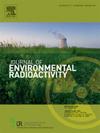火山旅游洞穴中氡时间序列的非线性和多分形去趋势波动分析
IF 1.9
3区 环境科学与生态学
Q3 ENVIRONMENTAL SCIENCES
引用次数: 0
摘要
放射性氡气对人类健康构成重大威胁。了解氡分布的复杂性以及与大气参数的动态关系有助于减轻其影响。本研究采用多分形去趋势波动分析法(MF-DFA)和混沌分析法来研究 2021 年 1 月至 2022 年 12 月期间特内里费岛 La Cueva del Viento 的氡气分形结构。结果表明,氡在 2021 年、2022 年和 2021-2022 年具有多分形特性,频谱值分别约为 0.43、0.49 和 0.44。研究发现,氡气的多分形性是由长程相关性和胖尾分布共同驱动的。La Cueva del Viento 的氡气浓度具有混沌性质,因此无法进行长期预测。研究发现,相对湿度、气温和气压等气象参数是造成洞内氡气浓度变化的原因。据观察,在 2021 年、2022 年和 2021-2022 年,相对湿度与氡气的交叉相关性最强。这项研究的结果将有助于对洞穴内的工人和游客进行剂量控制。本文章由计算机程序翻译,如有差异,请以英文原文为准。
Nonlinear and multifractal detrended fluctuation analysis of radon time series in a volcanic touristic cave
Radioactive radon gas poses significant threats to human health. Understanding the complexities of radon distribution and the dynamic relationship with atmospheric parameters will help in mitigating its impact. In this study, Multifractal Detrended Fluctuation Analysis (MF-DFA) and chaos analysis were used to examine the fractal structure in radon gas at La Cueva del Viento, Tenerife, between January 2021 and December 2022. The results showed that radon has multifractal properties in 2021, 2022, and 2021–2022, with values of the spectrum with of about 0.43, 0.49 and 0.44 respectively. The multifractality in radon gas was found to be driven by both long-range correlations and fat-tail distribution. Radon gas concentration at La Cueva del Viento was found to be chaotic in nature, hence, long-term prediction is impossible. Meteorological parameters such as relative humidity, air temperature and pressure were found to contribute to the variation in radon gas concentration within the cave. Relative humidity was observed to have the strongest cross-correlation with radon gas in 2021, 2022, and 2021–2022. The results from this study will help in dosimetric control for both workers and visitors to the cave.
求助全文
通过发布文献求助,成功后即可免费获取论文全文。
去求助
来源期刊

Journal of environmental radioactivity
环境科学-环境科学
CiteScore
4.70
自引率
13.00%
发文量
209
审稿时长
73 days
期刊介绍:
The Journal of Environmental Radioactivity provides a coherent international forum for publication of original research or review papers on any aspect of the occurrence of radioactivity in natural systems.
Relevant subject areas range from applications of environmental radionuclides as mechanistic or timescale tracers of natural processes to assessments of the radioecological or radiological effects of ambient radioactivity. Papers deal with naturally occurring nuclides or with those created and released by man through nuclear weapons manufacture and testing, energy production, fuel-cycle technology, etc. Reports on radioactivity in the oceans, sediments, rivers, lakes, groundwaters, soils, atmosphere and all divisions of the biosphere are welcomed, but these should not simply be of a monitoring nature unless the data are particularly innovative.
 求助内容:
求助内容: 应助结果提醒方式:
应助结果提醒方式:


